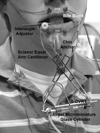OroSTIFF: Face-referenced measurement of perioral stiffness in health and disease
- PMID: 20185131
- PMCID: PMC2866840
- DOI: 10.1016/j.jbiomech.2010.01.037
OroSTIFF: Face-referenced measurement of perioral stiffness in health and disease
Abstract
A new device and automated measurement technology known as OroSTIFF is described to characterize non-participatory perioral stiffness in healthy adults for eventual application to patients with orofacial movement disorders associated with neuromotor disease, traumatic injury, or congenital clefts of the upper lip. Previous studies of perioral biomechanics required head stabilization for extended periods of time during measurement, which precluded sampling patients with involuntary body/head movements (dyskinesias), or pediatric subjects. The OroSTIFF device is face-referenced and avoids the complications associated with head-restraint. Supporting data of non-participatory perioral tissue stiffness using OroSTIFF are included from 10 male and 10 female healthy subjects. The OroSTIFF device incorporates a pneumatic glass air cylinder actuator instrumented for pressure, and an integrated subminiature displacement sensor to encode lip aperture. Perioral electromyograms were simultaneously sampled to confirm passive muscle state for the superior and inferior divisions of the orbicularis oris muscles. Perioral stiffness, derived as a quotient from resultant force (DeltaF) and interangle span (DeltaX), was modeled with multilevel regression techniques. Real-time calculation of the perioral stiffness function demonstrated a significant quadratic relation between imposed interangle stretch and resultant force. This stiffness growth function also differed significantly between males and females. This study demonstrates the OroSTIFF 'proof-of-concept' for cost-effective non-invasive stimulus generation and derivation of perioral stiffness in a group of healthy unrestrained adults, and a case study to illustrate the dose-dependent effects of Levodopa on perioral stiffness in an individual with advanced Parkinson's disease who exhibited marked dyskinesia and rigidity.
Copyright 2010 Elsevier Ltd. All rights reserved.
Conflict of interest statement
The authors confirm that there are no conflicts of interest associated with this publication and there has been no financial support for this work that could have influenced its outcome.
Figures







Similar articles
-
Modification of perioral stiffness in patients with repaired cleft lip and palate.Cleft Palate Craniofac J. 2012 Sep;49(5):524-9. doi: 10.1597/10-092. Epub 2011 Jan 19. Cleft Palate Craniofac J. 2012. PMID: 21247345 Free PMC article. Clinical Trial.
-
Face-referenced measurement of perioral stiffness and speech kinematics in Parkinson's disease.J Speech Lang Hear Res. 2015 Apr;58(2):201-12. doi: 10.1044/2015_JSLHR-S-13-0293. J Speech Lang Hear Res. 2015. PMID: 25629806 Free PMC article.
-
Nonparticipatory stiffness in the male perioral complex.J Speech Lang Hear Res. 2009 Oct;52(5):1353-9. doi: 10.1044/1092-4388(2009/08-0101). Epub 2009 Aug 28. J Speech Lang Hear Res. 2009. PMID: 19717655 Free PMC article.
-
Automatic measurement of nonparticipatory stiffness in the perioral complex.J Speech Lang Hear Res. 2007 Oct;50(5):1272-9. doi: 10.1044/1092-4388(2007/089). J Speech Lang Hear Res. 2007. PMID: 17905911
-
Filling Procedures for Lip and Perioral Rejuvenation: A Systematic Review.Rejuvenation Res. 2018 Dec;21(6):553-559. doi: 10.1089/rej.2017.1941. Epub 2018 Aug 8. Rejuvenation Res. 2018. PMID: 29911505
Cited by
-
Modification of perioral stiffness in patients with repaired cleft lip and palate.Cleft Palate Craniofac J. 2012 Sep;49(5):524-9. doi: 10.1597/10-092. Epub 2011 Jan 19. Cleft Palate Craniofac J. 2012. PMID: 21247345 Free PMC article. Clinical Trial.
-
Face-referenced measurement of perioral stiffness and speech kinematics in Parkinson's disease.J Speech Lang Hear Res. 2015 Apr;58(2):201-12. doi: 10.1044/2015_JSLHR-S-13-0293. J Speech Lang Hear Res. 2015. PMID: 25629806 Free PMC article.
-
Instrumented Assessment of Oral Motor Function in Healthy Subjects and People with Systemic Sclerosis.Dysphagia. 2015 Jun;30(3):286-95. doi: 10.1007/s00455-015-9597-2. Epub 2015 Feb 17. Dysphagia. 2015. PMID: 25687967
-
Wireless Sensing of Lower Lip and Thumb-Index Finger 'Ramp-and-Hold' Isometric Force Dynamics in a Small Cohort of Unilateral MCA Stroke: Discussion of Preliminary Findings.Sensors (Basel). 2020 Feb 23;20(4):1221. doi: 10.3390/s20041221. Sensors (Basel). 2020. PMID: 32102239 Free PMC article.
-
Changes in facial expressions can distinguish Parkinson's disease via Bayesian inference.Front Neurol. 2025 Mar 27;16:1533942. doi: 10.3389/fneur.2025.1533942. eCollection 2025. Front Neurol. 2025. PMID: 40212609 Free PMC article.
References
-
- Al-Hoqail RA, Meguid EMA. An anatomical and analytical study of the modiolus: enlightening its relevance to plastic surgery. Aesthetic Plastic Surgery. 2009;33:147–152. - PubMed
-
- Barlow SM. The effects of speech-orofacial motor performance by means of motion sense. Journal of Communication Disorders. 1998;31:511–534. - PubMed
-
- Barlow SM. Mechanical frequency detection thresholds in the human face. Experimental Neurology. 1987;96:253–261. - PubMed
-
- Barlow SM, Abbs JH. Fine force and position control of select orofacial structures in the Upper Motor Neuron Syndrome. Experimental Neurology. 1986;94:699–713. - PubMed
-
- Barlow SM, Iacono RP, Paseman LA, Biswas A, D’Antonio LD. The effects of experimental posteroventral pallidotomy on force and speech aerodynamics in Parkinson’s disease. In: Cannito MP, Yorkston KM, Beukelman DR, editors. Speech Motor Control. Baltimore: Paul H. Brookes Publishing Company; 1998. pp. 117–156.
Publication types
MeSH terms
Grants and funding
LinkOut - more resources
Full Text Sources
Medical

